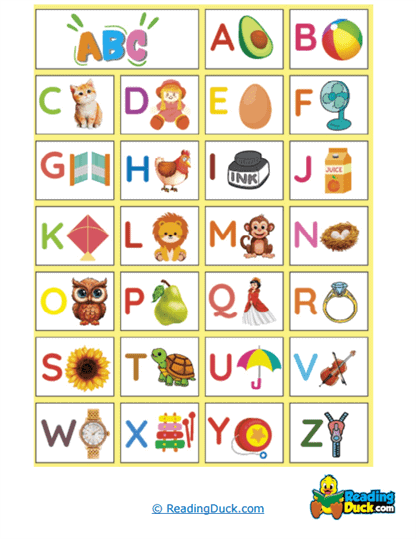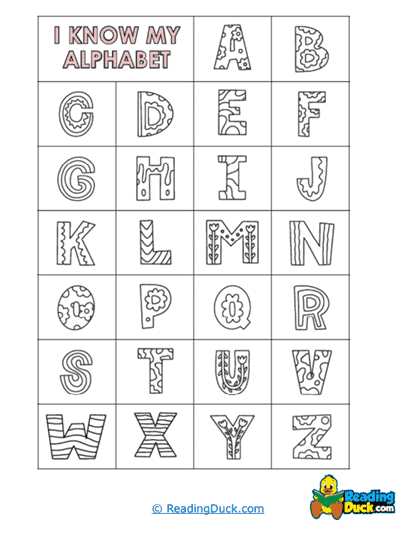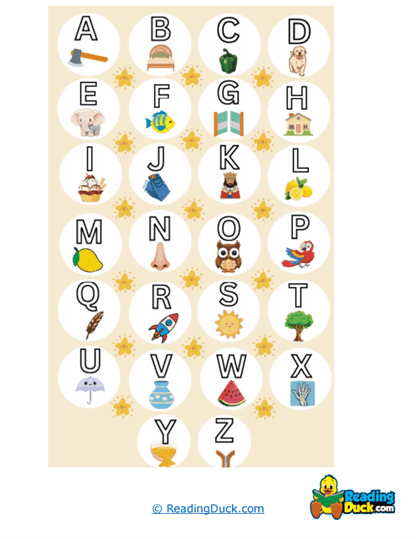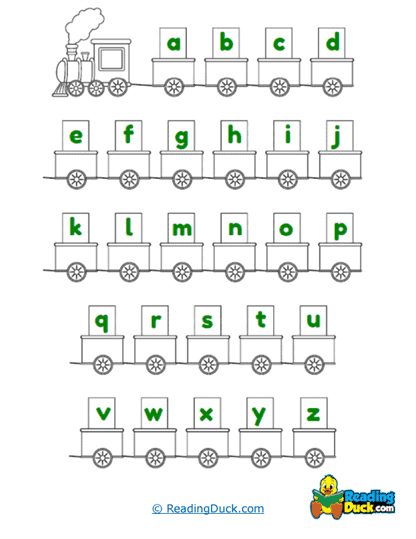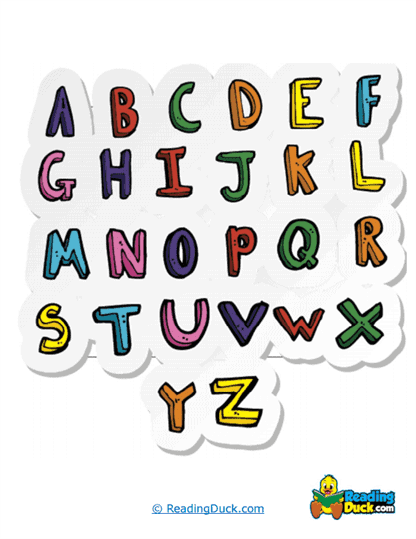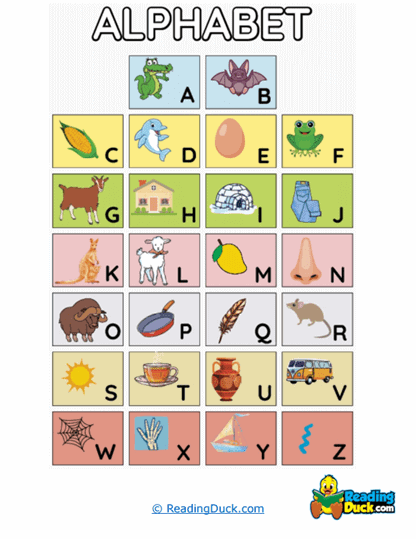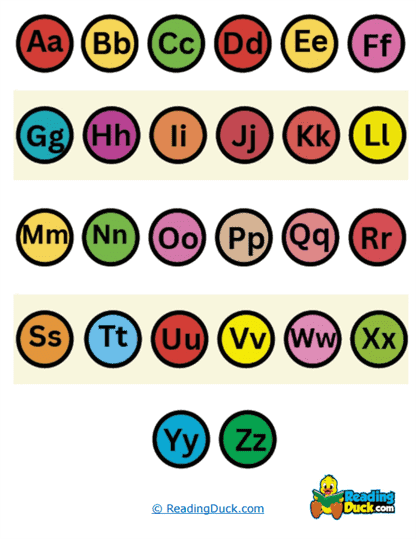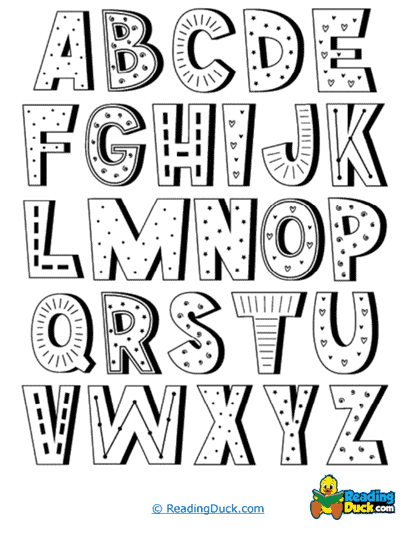ABC Alphabet Charts Worksheets
About Our ABC Alphabet Charts
The ABC Alphabet Charts Worksheets collection is designed to introduce young students to the world of letters in an engaging and visually stimulating way. These worksheets are crafted with creative designs that capture the attention of early learners, making the process of familiarizing themselves with the alphabet both fun and educational. Available in a PDF format, these worksheets can be easily accessed electronically, downloaded, and printed, allowing for versatile use in various educational settings.
Understanding the Alphabet: Building Blocks of Literacy
The alphabet serves as the foundation for literacy, acting as the gateway to reading, writing, and effective communication. Introducing students to the alphabet is a critical step in their educational journey, as it provides them with the basic tools they need to decode language and build their vocabulary. Here's how teachers can present this topic to students:
- The Significance of Letters: Each letter in the alphabet represents a specific sound or group of sounds in spoken language. Understanding these sounds, known as phonemes, is crucial for developing reading skills. Teachers can explain to students that letters are like puzzle pieces that, when combined, create words and sentences.
- Letter Recognition: Recognizing letters by sight is one of the first steps in literacy. Students learn to identify each letter by its shape, both uppercase and lowercase, and associate it with its corresponding sound. This recognition is fundamental in enabling students to move on to more complex literacy skills.
- Letter-Sound Correspondence: Understanding the relationship between letters and their sounds is a key aspect of early reading instruction. Teachers can emphasize the importance of matching letters to the sounds they represent, which is a skill that will help students when they start to decode words.
- Alphabetical Order: The concept of alphabetical order is another essential aspect of learning the alphabet. This skill helps students understand how words are organized in dictionaries, how to sort information, and how to follow along with texts that use alphabetical headings.
- Interactive and Multi-Sensory Learning: Engaging students with the alphabet involves more than just visual recognition. Teachers can incorporate songs, chants, and physical activities that connect letters with sounds and movements. This multi-sensory approach ensures that different learning styles are catered to, making the learning process more effective.
- Cultural and Linguistic Variations: It’s important for students to understand that while the English alphabet has 26 letters, different languages may have different alphabets or additional letters. Teachers can introduce this concept to broaden students’ understanding of global languages and cultures.
Through these aspects, students can gain a comprehensive understanding of the alphabet, laying the groundwork for more advanced literacy skills. The ABC Alphabet Charts Worksheets serve as a tool to reinforce these concepts, helping students to solidify their knowledge in a structured and enjoyable way.
Where To Use These Worksheets
Integrating the ABC Alphabet Charts Worksheets into your curriculum can be done in a variety of creative and effective ways. Here are some tangible tips and ideas:
- Kindergarten and Pre-Kindergarten Lessons: These worksheets are perfect for introducing letters to students in kindergarten and pre-kindergarten. Use them during letter-of-the-week activities where each chart corresponds to the letter being taught that week.
- Morning Circle Time: Incorporate these charts into your morning routine. Display a chart, and as a group, practice saying the letter, identifying objects that begin with that letter, and tracing the letter with fingers or writing tools.
- Literacy Centers: Set up a literacy center in your classroom where students can work independently or in small groups with these worksheets. Encourage them to trace the letters, color the charts, and discuss the sounds each letter makes.
- Homework Assignments: Send these worksheets home as part of a weekly homework packet. Parents can assist their children in completing the worksheets, reinforcing what they’ve learned in class.
- Special Education Settings: These charts can be particularly useful in special education classrooms where students may need more time and practice to master letter recognition. The visual appeal and simple design of the charts make them accessible for students with different learning needs.
- Early Literacy Intervention Programs: Use these worksheets in early literacy intervention settings to support students who may be struggling with letter recognition and sound correspondence. The structured format can help in building confidence and skills in these students.
- ESL (English as a Second Language) Classes: For students learning English as a second language, these worksheets provide a clear and simple way to understand the basics of the English alphabet, helping them to build a strong foundation in their new language.
- Summer Enrichment Programs: Incorporate these worksheets into summer learning programs to prevent the “summer slide” and keep young learners engaged in educational activities during the break.
These worksheets are versatile and can be adapted to fit the needs of various grade levels, particularly benefiting students in pre-kindergarten through first grade. By integrating them into different parts of the curriculum, teachers can ensure that students receive ample practice and reinforcement in their journey to mastering the alphabet.
Fostering Literacy and Cognitive Development
Engaging with ABC Alphabet Charts Worksheets is more than just a fun activity; it is a critical step in a child’s cognitive and academic development. Here’s how studying the alphabet through these worksheets can improve various skills:
- Literacy Development: By consistently practicing letter recognition and sound correspondence, students build the foundational literacy skills that will enable them to decode words, comprehend texts, and eventually read fluently.
- Fine Motor Skills: Tracing and writing letters on the worksheets help to develop fine motor skills, particularly the coordination needed to hold and control a pencil. This skill is essential for writing and other tasks that require precise hand movements.
- Visual Discrimination: Learning to differentiate between letters, especially those that are visually similar (like “b” and “d”), enhances students’ visual discrimination skills. This ability is important not only in reading but also in everyday tasks that involve recognizing and interpreting visual information.
- Memory and Recall: Repeated exposure to the alphabet through these charts helps strengthen memory and recall abilities. As students learn to associate each letter with a specific sound or image, they develop stronger memory retention, which is crucial for academic success.
- Language and Vocabulary Expansion: By associating letters with words and objects (e.g., “A is for Apple”), students begin to expand their vocabulary. This practice also supports language development as they learn to articulate sounds and words associated with each letter.
- Cognitive Development: The process of learning the alphabet engages various cognitive functions, including pattern recognition, sequencing, and categorization. These cognitive skills are not only vital for literacy but also for problem-solving and critical thinking in other academic areas.
- Confidence and Independence: As students master the alphabet, they gain confidence in their ability to learn and accomplish tasks. This self-assurance fosters independence, encouraging them to take on new challenges in their educational journey.
Through the use of these worksheets, students can develop a robust set of skills that will serve as the foundation for their future academic endeavors. The ABC Alphabet Charts Worksheets are not just a tool for learning letters; they are a comprehensive resource that supports the holistic development of early learners, preparing them for the many challenges and opportunities that lie ahead in their education.
